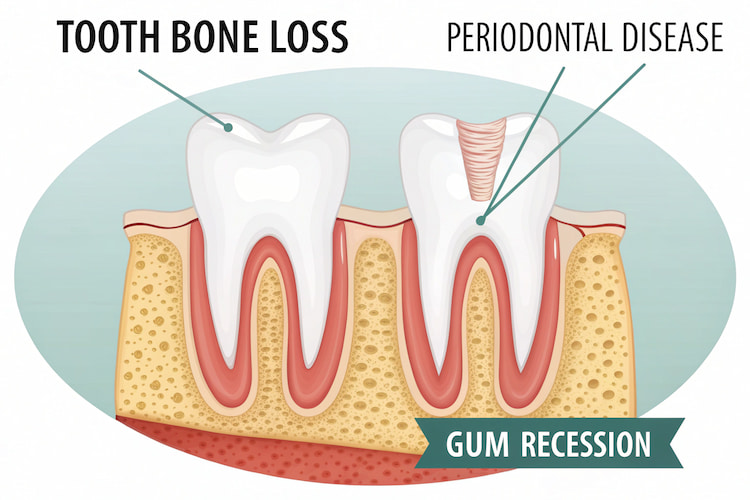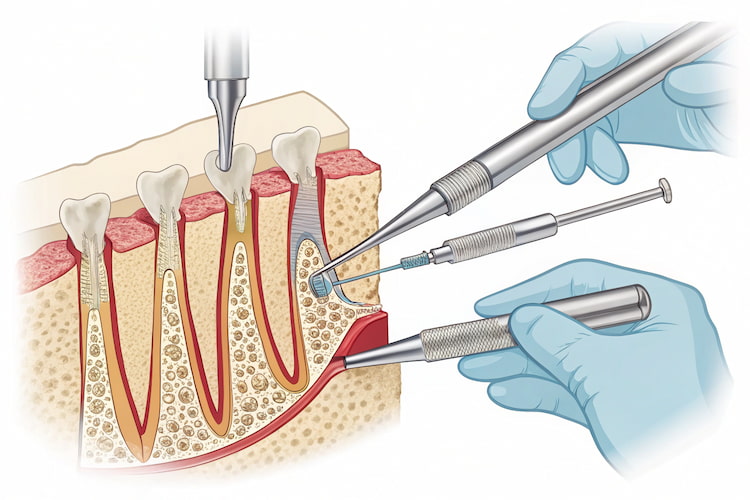Losing a tooth is challenging, but losing the bone that supports it makes things even more complicated. If you’ve been told you have jawbone loss, you might be wondering: Can I still get dental implants? The good news is, yes, in many cases, you can. Thanks to modern dental advancements, patients with bone loss often have options when it comes to implants.
In this guide, we’ll explore what bone loss means, its impact on implant procedures, and the solutions available to restore both your smile and your confidence.

What Is Bone Loss?
Bone loss in the jaw happens when bone tissue begins to shrink or deteriorate, usually as a result of missing teeth, gum disease, or aging. When a tooth is lost and not replaced, the jawbone no longer gets stimulation from chewing. Over time, it begins to shrink, a process called bone resorption.

Common causes of bone loss include:
- Missing teeth over time
- Periodontal (gum) disease
- Chronic infection
- Trauma or injury
- Aging and hormonal changes
Bone loss doesn’t just affect your ability to get dental implants; it can also lead to facial sagging and shifting of nearby teeth.
How Bone Loss Affects Dental Implants
Dental implants work by fusing with the jawbone in a process called osseointegration. When there’s not enough bone to hold the implant in place, it may become unstable or fail.
But that doesn’t mean implants are off the table. Dentists have several tools and techniques to work around bone loss and restore a stable foundation.
Solutions for Dental Implants with Bone Loss
Thankfully, modern dentistry offers several approaches for patients with bone loss who want dental implants.

Bone Grafting Procedures
Bone grafting involves placing bone material (from your body, a donor, or synthetic sources) in areas of loss. This encourages natural bone regeneration and creates a solid base for implants. Healing after a graft usually takes a few months before the implant can be placed.
Alternative Implant Techniques
In cases where bone grafting isn’t suitable or desired, dentists may use specialized implant techniques, including:
- Zygomatic implants: Anchored into the cheekbone instead of the jaw
- Mini implants: Smaller and require less bone volume
- All-on-4® implants: Tilted implants that can often avoid bone-deficient areas
These methods allow many patients with moderate to severe bone loss to receive stable, lasting implants.
Advanced Diagnostic Tools
Before any decision is made, your dentist will use tools like 3D cone-beam CT scans to assess your bone structure. These scans show detailed images of your jawbone and help determine the best solution for your unique case.
If you’re considering implants and have osteoporosis, learn how this condition can impact your treatment in Healthline’s guide on osteoporosis and dental implants.
Benefits of Implants with Bone Loss Solutions
Even if you’ve lost bone in your jaw, dental implants, along with bone grafting or special techniques, can still offer great results. Here’s how they can improve your life:
Restored Functionality
With dental implants, you can eat, speak, and smile like you used to. They’re fixed in place, so there’s no slipping or moving around like with dentures. You’ll be able to chew foods like meat, apples, or nuts without pain or worry.
Improved Aesthetics
When you lose bone in your jaw, your face can start to look sunken or older. Implants help fill out your cheeks and lips, making your face look fuller and more natural again.

Long-Term Durability
Dental implants can last many years, often over 15 to 20 years, with proper care. Even when bone grafting is needed, they remain strong and stable over time.
Enhanced Oral Health
Implants help protect the rest of your mouth. They don’t damage nearby teeth, and they help stop further bone loss by keeping your jawbone active when you chew.
Cost of Dental Implants with Bone Loss Treatments
The cost of implants with bone loss depends on the procedures involved. Additional steps, like bone grafting or zygomatic implants, will increase the overall investment.
| Treatment Type | Estimated Cost |
|---|---|
| Single Dental Implant | $3,000 – $5,800 |
| Bone Graft (per site) | $300 – $1,200+ |
| Implant + Bone Graft | $3,500 – $7,000+ |
| Zygomatic Implant | $6,000 – $15,000 |
| All-on-4 Full Arch | $24,000 – $40,000 |
| Sinus Lift (if needed) | $1,500 – $3,500 |
| 3D Imaging & Consultation | $150 – $500 |
These are average ranges as of July 2025. Actual costs depend on your location, your dentist, the materials used, and your treatment plan.
Ready to take the first step?
Talk to our implant specialist and find out if you’re a candidate, even with bone loss. A healthier, more confident smile could be closer than you think.
Risks and Limitations of Implants with Bone Loss
Like all procedures, implants in cases of bone loss come with considerations. Understanding these helps you make informed decisions.
Procedure Complexity
Placing implants in patients with bone loss requires extra steps, such as grafting or alternative placement methods. This means more planning and possibly longer treatment timelines.
Longer Recovery Time
Bone grafting may require 3–6 months to heal before implants can be placed. After that, implants may take another 3–4 months to fully integrate.
While this timeline may seem long, the result is a permanent and natural-looking replacement tooth that can last a lifetime.
Who Is Eligible for Implants with Bone Loss?
Most people with bone loss can still get dental implants, especially with today’s advanced treatments. But whether you’re a good candidate depends on your overall health and how well your body can heal.

Factors Affecting Candidacy
Your dentist will check if you’re in generally good health and if you have any medical conditions, like diabetes, that need to be under control before starting treatment. It’s also important that your gums are healthy and that you take good care of your teeth. If you smoke, your dentist may ask you to quit during the healing process, since smoking can slow things down and affect the success of the implant.
Everyone is different, so your dentist will look at your unique case and help you decide if implants are the right choice for you.
Sum Up
Bone loss doesn’t mean you have to give up on dental implants. With today’s advanced techniques like bone grafting, mini or zygomatic implants, and 3D digital planning, most patients with bone loss can still enjoy the benefits of a strong, natural-looking smile.
The best way to know your options? Schedule a consultation with an experienced implant dentist and explore a solution tailored just for you.
FAQs
-
Can bone loss be reversed?
While bone loss isn’t fully reversible, bone grafting and regenerative treatments can rebuild enough bone to support implants.
-
What is bone grafting?
Bone grafting adds bone material to areas of loss, encouraging your body to grow new bone and create a solid base for dental implants.
-
Are implants safe with bone loss?
Yes, with the right evaluation and treatment, dental implants are generally safe and highly successful, even with prior bone loss.
-
How long does recovery take?
If bone grafting is involved, healing may take 3–6 months before placing implants. After implant placement, healing typically takes 3–4 months before the final crown is added.
Have you had dental implants with bone loss, or are you considering them?
Share your questions or experiences below; we’d love to hear from you.




